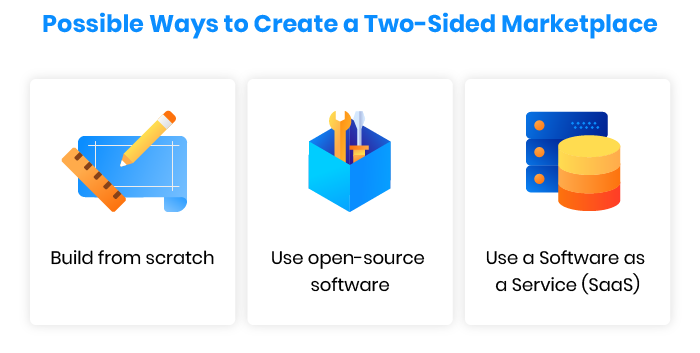-
Product Management
Software Testing
Technology Consulting
-
Multi-Vendor Marketplace
Online StoreCreate an online store with unique design and features at minimal cost using our MarketAge solutionCustom MarketplaceGet a unique, scalable, and cost-effective online marketplace with minimum time to marketTelemedicine SoftwareGet a cost-efficient, HIPAA-compliant telemedicine solution tailored to your facility's requirementsChat AppGet a customizable chat solution to connect users across multiple apps and platformsCustom Booking SystemImprove your business operations and expand to new markets with our appointment booking solutionVideo ConferencingAdjust our video conferencing solution for your business needsFor EnterpriseScale, automate, and improve business processes in your enterprise with our custom software solutionsFor StartupsTurn your startup ideas into viable, value-driven, and commercially successful software solutions -
-
- Case Studies
- Blog
Building a Peer-to-Peer Marketplace: Use a Ready Platform or Do It from Scratch
Building peer-to-peer marketplaces is popular nowadays, but it’s not always clear how to create a powerful marketplace similar to eBay. If you want to create a two-sided marketplace, you basically have three options. First, you can develop your marketplace from scratch. Second, you can build a marketplace with open-source software such as Sharetribe or Magento. Finally, you can use a Software as a Service (SaaS) solution such as Sharetribe (paid version), Near Me, or Marketplacer.

We’ll talk about the pros and cons of each marketplace development option below to help you choose. Meanwhile, let’s define what a peer-to-peer marketplace is.
What’s a P2P marketplace Marketplace?
A peer-to-peer or P2P marketplace is an online platform that connects people in need of a product temporarily with people who have that product, but are not using it. Through a P2P marketplace, people can rent out a product in exchange of money or a similar product only for the time they need it.
Let’s begin by drawing a solid line between online stores and web marketplaces, since they’re often confused. Although online stores and web marketplaces are both ecommerce websites, in reality they provide different functionality.
You may have heard about the Magento and Spree Commerce platforms, which are often recommended for building marketplaces. But Magento and Spree don’t allow individual users to sell their products, as these platforms are designed for developing online stores.
An ecommerce store provides a single storefront where users can only buy products or services. On your ecommerce store, you are the mediator between the product manufacturer and the buyer, and you decide what products to sell at what price.
Online marketplaces, on the other hand, allow users to sell things. They can be classified according to who uses them:
- Only businesses – B2B (business-to-business)
- Businesses and consumers – B2C (business-to-consumer)
- Only consumers/individuals – P2P (peer-to-peer)
We’ve already written an extensive guide to this classification so you can learn it in detail.
One more approach to classifying marketplaces is dividing them by industry. These are the industries that most commonly use marketplaces and the key players in each industry:
- Travel (Airbnb, Expedia, Booking.com)
- Education (Coursera, Udemy)
- Ecommerce & Retail (Amazon)
- Healthcare (Zocdoc)
- Human resources (Upwork)
- Finance (Opendoor)
Some sources suggest classifying marketplaces according to the types of products or services they offer:
- Product sales
- Rental services
- Booking services
- Consulting services
How a Two-sided Marketplace is Different from Online Stores?
You can develop a two-sided marketplace platform where each user can have their own storefront to sell products or services. More specifically, users will become vendors on your marketplace and they will create product listings, get ratings, and even exchange products from their accounts – things typically not possible through an online store.
Technically speaking, you can build peer-to-peer marketplace software with Spree Commerce, Magento, or a similar ecommerce platform. You only need to add marketplace functionality on top of your online store to let users sell or share their products. We would call this kind of product a compound ecommerce website – an online store plus a marketplace.
Newegg is a perfect example of such a website: Newegg is an ecommerce store that sells computers and computer parts, but registered users can also sell their own computer parts
| Two-sided marketplace | Online store |
|---|---|
| Multiple vendors | One vendor |
| Provides all functionality and support | Sellers take care of functionality themselves |
| Variable sales model | Fixed sales model |
| May or may not have actual inventory and a warehouse | Needs its own warehouse(s) |
Why Build a Peer-to-Peer Marketplace from Scratch in 2020?
Let's review the first option for how to create an online marketplace. Building an online marketplace from scratch demands much effort, time, and expense. Given that it’s always best to deliver your product as quickly as possible, why should you even consider this option? The main reason is to make your marketplace unique. You can create a marketplace with a fully original user interface and user experience, and you can implement only the business logic you need.
Take a look at Pindify for an example of a fully custom-built marketplace.
Pindify is a peer-to-peer marketplace for artists that we recently developed. As you can see, Pindify doesn’t have the usual Amazon-like interface, but is a perfect example of how unique your marketplace may look like if built from scratch.

Besides developing a unique appearance for your marketplace, you can also build the app architecture that will suit your application best. With a ready platform, it’s almost impossible to rewrite some parts of the platform without breaking your application in the process. In other words, an online marketplace that’s built from scratch is more flexible than a platform-based product.
You’re also free to choose the technology stack for your marketplace project. And should your marketplace grow to Airbnb scale, you’ll be able to change more code than with a ready platform to achieve the best application performance.
These are the three reasons why you might opt for peer-to-peer marketplace development from scratch: choice of technology stack, flexible architecture, and unique design. But what if you really want to enter the market rapidly? This is when ready ecommerce platforms come in handy. In the following section, we’ll review which ready marketplace platforms you can use and why you might choose them.
Build Your P2P Marketplace Quicker with a Ready Platform
If you're questioning how to build a marketplace in a simpler way, here's another option – ready platforms.
What’s really great about developing a modern marketplace is that you can use open source (read free) platforms. There are many ecommerce platforms out there – Magento, Sharetribe, Drupal, OpenCart, Spree Commerce, and others. But, as we mentioned earlier, not all these solutions are suitable for a marketplace project. Actually, only one of these platforms is a marketplace platform, and that is Sharetribe. All other solutions are designed for online stores.
This doesn’t mean that you can only use Sharetribe for your marketplace. You can still use Magento, for example, but you’ll have to install a Magento extension to add marketplace functionality. Since Magento is a very popular Content Management System it has plenty of marketplace extensions, namely Magento Marketplace, Multi Vendor Module, and uMarketplace Suite. It’s the same story with Drupal Commerce – you’ll need an extension, usually paid, to make a Drupal-based website work as a marketplace.
But let’s get back to Sharetribe and consider its benefits over Magento and other ecommerce CMSs. Developing a peer-to-peer marketplace with Sharetribe is simpler than with Magento, as Sharetribe was tailored to accomplish this exact task. And Sharetribe provides all marketplace functionality for free, meaning you don’t need to pay for it as you do for Magento extensions.
Using this true marketplace platform, you can focus on implementing distinctive functionalities and a distinctive user interface. Some necessary marketplace features are available with Sharetribe right out of the box: product listings, personal storefronts, and PayPal support, to name a few. You only need a development team to implement additional functionalities such as additional payment gateways or a custom user interface. Since Sharetribe is based on the Ruby on Rails framework, you’ll need a team that is expert with Ruby (the programming language) and Rails.
If you opt for Sharetribe or Magento, you’ll save money on your marketplace project development compared to building a completely custom product. But let’s go further and figure out how you can spend even less time, effort, and money to launch a peer-to-peer marketplace by using a Software as a Service marketplace solution.
Consider a Software as a Service Marketplace
You don't have to build an ecommerce marketplace platform from scratch as you can use ready online marketplace software. Software as a Service (SaaS) marketplace products are very popular nowadays, as they allow you to launch your marketplace faster than with any other option. You can pay a SaaS marketplace vendor for hosting, technical support, and software updates. The main advantages of such an approach are simplicity and low price: you can rapidly launch a marketplace without a development team and simply access the backend interface from your browser.
There are three popular vendors of SaaS marketplace solutions – Sharetribe, Marketplacer, and Near Me. Check out the table below for a quick overview of the features that these Software as a Service solutions provide.
| Marketplace | Sharetribe | Near Me | Marketplacer |
|---|---|---|---|
| Pricing and Plans | $79 /month – Hobby $119 /month – Pro $159 /month – Growth $239 /month – Scale |
$1,000 /month – Starter $2,000 /month – Pro |
Not Available |
| Payment | PayPal Credit Card |
PayPal Credit Card |
PayPal Credit Card |
| Customizations | HTML + CSS Custom landing page |
HTML + CSS Feature customization |
Feature customization |
| Custom Domain | Supported for top 3 plans | Yes | Yes |
| Mobile Friendly | Yes | Yes | Yes |
| Search Engine | Custom Headings Metadata Content management |
Custom Headings Metadata Content management |
Custom Headings Metadata Content management |
| Technical Support | Available 24/7 | Available 24/7 | Available 24/7 |
| Security | SSL Certificate PCI Compliant |
SSL Certificate PCI Compliant |
SSL Certificate PCI Compliant |
| Analytics | Google Analytics | Google Analytics Traffic Effectiveness Campaign Effectiveness |
Google Analytics Seller Performance Advertisement Performance Financial Reports |
| Target Audience | Individual Entrepreneurs | Individual Entrepreneurs Brands |
Individual Entrepreneurs |
You can request for different services when using these platforms, such as additional marketplace setup or to create a unique landing page, etc.We also want to mention a few shortcomings of using a SaaS marketplace.
With a SaaS marketplace, you’re locked into how Sharetribe, Marketplacer, and Near Me update and upgrade their marketplace platforms. If you want additional functionality, you won’t be able to immediately develop and deploy this functionality on your own. Plus, each of these marketplace platforms is paid – but at the same time, you don’t need to think about where to deploy your marketplace or how to support it.
All these vendors do provide several themes and allow for small customizations, but that’s not enough if you want a more elaborate design. Near Me and Sharetribe allow you to work with HTML and CSS, and this is only frontend design, not business logic.
With Sharetribe, it’s still possible to move your marketplace to a new hosting provider and take full control of your project. If your Sharetribe-based marketplace takes off, you can always migrate your code from their SaaS and get more control over it. This is impossible with Marketplacer and Near Me.
The bottom line is that you can pay a monthly subscription, get a fairly customizable frontend solution, and launch and support a marketplace with little effort. Software as a Service marketplaces are great, so long as you understand the limitations we described above.
How to Make a Peer-to-Peer Marketplace Website
Which one of these three options should you choose for building your own peer-to-peer marketplace?
First, ask yourself what you actually want to create. If you want to build an online store, use Magento or Spree Commerce. But if you want to build the next Airbnb, you should consider a different platform such as Sharetribe, which provides features specific to marketplaces.
Alternately, you can choose a Software as a Service marketplace to spend the least time and effort on developing your project. This option comes with several tradeoffs, though, as your marketplace can hardly be called unique. But it does save time, and with SaaS you can start a peer-to-peer online marketplace in a matter of weeks.
And as a final option, you can always consider building your two-sided marketplace from scratch to make it one-of-a-kind.
If you feel like building a marketplace with a reliable and experienced team, feel free to contact us and describe your business idea!
















